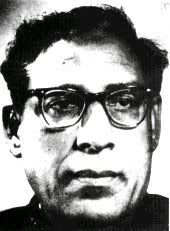
A mehfil of Amir Khan was always a pleasant experience. He had a very impressive and magnetic personality. At his concerts he would always sit in the posture of a Yogi, with closed eyes and in deep meditation. He maintained the same position till the end of his concert. His smiling presence, total lack of gesticulation or facial distortion, his absolute concentration on the song, and the slow, gradual build-up of a Raga invariably kept his audience completely engrossed. He had, for accompaniment, two Tanpuras tuned to perfection, a subdued Harmonium and a Tabla with a straight, simple but steady tempo. An atmosphere of solemnity and tranquility prevailed in his concerts.
Abhogi Vilambit (Charan Dhar Aaye) :
Abhogi (Laaj Rakh Lijo Mori) & Shahana (Sundar Angana Baithi) :
Amir Khan's forte was the exaggeratedly slow or Vilambit Khayal which he developed in a most leisurely mood with deep serenity and contemplativeness. While his ardent admirers found this part of his concert absolutely engrossing, there were others who found it 'excruciatingly slow' or even 'insipid'. Although Amir Khan never rendered Thumris in his concerts, his disciples speak of the exquisite way in which he rendered Thumris for them in his intimate 'home circle'. He once said that since he considered Bade Ghulam Ali Khan as a better singer of Thumri, he had decided against public exposition of his capacity for the same. This certainly speaks for the genuine admiration of one genius for another.
Bageshri (Gore Gore Mukh Par) :
Megh (Barkha Ritu Aayi) & Tarana :
He did not agree with the popular notion that the Tarana was just a tongue-twisting exercise with a meaningless cluster of words, involving a lot of vocal jugglery in an ever-increasing tempo. He always put into a Tarana, a Persian couplet interwoven in the apparently meaningless 'Dir tun, tan, din yalali, yalallum', and honestly believed that these syllables did have some mysterious and mystic meaning. According to him it was Amir Khusrau who invented the Tarana. Amir Khan was very keen on establishing this theory by carrying out research to unravel the hidden meanings of the Tarana.
Amir Khan was also a good composer and some of his compositions reflect the religious convictions of his. One example is 'Laaj rakh lijo mori, Saheb, Sattar, Nirakaar, Jag ke data, Tu Rahim, Ram Tu, Teri maaya aparampar, Mohe tore karam ko aadhar, Jagat ke data...'. He died on 13th February 1974 in a tragic car accident in Calcutta. The world of Indian music went into mourning, and programmes of tributes to the departed maestro were broadcast from all the important stations of All India Radio.



2 comments:
It is sad that the new generation don't even now about this most influential figures in Hindustani classical music.I can't forget the song he sang in Baiju Bawra.
web designer
Ustad Amir Khan himself did not become follower of any particular gharana, but due to his work and contribution, he became a legend, worth to be followed by the coming generation. Therefore his distinct gharana (Indore) was developed.
Post a Comment